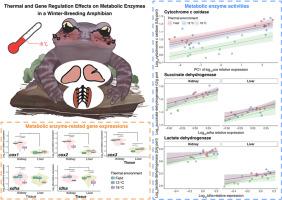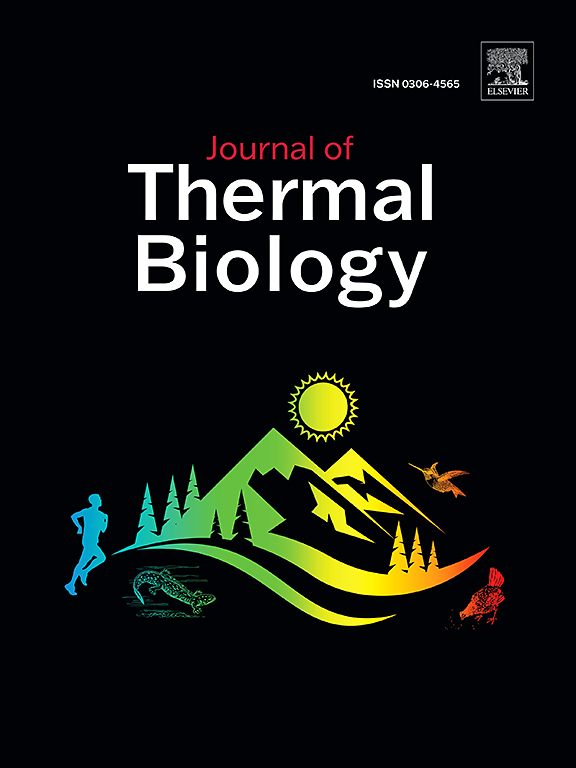Combined effects of thermal environment and gene regulation on metabolic enzyme activities of major metabolic tissues in a winter-breeding amphibian
IF 2.9
2区 生物学
Q2 BIOLOGY
引用次数: 0
Abstract
Variations in thermal environments can provoke diverse physiological responses in amphibians. Despite extensive studies on the thermal sensitivity of amphibian metabolic physiology, including enzyme activity at different temperatures, the rationale for selecting specific metabolic enzymes and their relationship with gene expression remains unclear. Cytochrome c oxidase (CCO), succinate dehydrogenase (SDH), and lactate dehydrogenase (LDH) are key metabolic enzymes within the primary metabolic regulatory tissues of animals. Through a comparative analysis of the effects of two different thermal conditions (12 and 18 °C) on the activities and mRNA expression levels of these enzymes within the kidney and liver tissues of a winter-breeding amphibian (Leptobrachium liui), with the field group during the breeding season as the control, we provide insights into the interplay between temperature and gene expression. The mRNA levels of CCO subunits 1 (cox1), 2 (cox2), and 3 (cox3), and LDH subunit A (ldha) were significantly higher in the kidney than in the liver of all individuals. High-temperature acclimation resulted in significantly decreased expression levels of cox1-3, ldha, and SDH complex flavoprotein subunit A (sdha) in the kidney. In the liver, the expression levels of sdha and ldha significantly reduced under high-temperature treatment, whereas cox3 expression increased. SDH and LDH activities displayed tissue-specific variations, while no significant differences in CCO activity were observed between tissues. CCO, SDH, and LDH activities in both liver and kidney tissues significantly declined after high-temperature acclimation, but simultaneously increased with up-regulated gene expression, indicating that the thermal environment and corresponding gene expression combined affect the activities of these metabolic enzymes. In conclusion, the thermal environment is a key factor affecting the physiological and biochemical responses of L. liui. Prolonged exposure to high temperatures during the breeding season could inhibit the activity of primary metabolic enzymes in the winter-breeding amphibian.

热环境和基因调控对冬眠两栖动物主要代谢组织代谢酶活性的综合影响
热环境的变化会引起两栖动物不同的生理反应。尽管对两栖动物代谢生理的热敏感性(包括不同温度下的酶活性)进行了大量研究,但选择特定代谢酶的理由及其与基因表达的关系仍不清楚。细胞色素 c 氧化酶(CCO)、琥珀酸脱氢酶(SDH)和乳酸脱氢酶(LDH)是动物主要代谢调节组织中的关键代谢酶。通过比较分析两种不同温度条件(12 °C和18 °C)对冬繁两栖动物(Leptobrachium liui)肾脏和肝脏组织中这些酶的活性和mRNA表达水平的影响,并以繁殖季节的野外组为对照,我们深入了解了温度与基因表达之间的相互作用。所有个体肾脏中CCO亚基1(cox1)、2(cox2)、3(cox3)和LDH亚基A(ldha)的mRNA水平均显著高于肝脏。高温驯化导致肾脏中 cox1-3、ldha 和 SDH 复合物黄蛋白亚基 A(sdha)的表达水平明显下降。在肝脏中,高温条件下 sdha 和 ldha 的表达水平明显降低,而 cox3 的表达水平则升高。SDH和LDH活性显示出组织特异性变化,而CCO活性在不同组织间无明显差异。高温驯化后,肝脏和肾脏组织中的 CCO、SDH 和 LDH 活性显著下降,但同时基因表达上调,CCO、SDH 和 LDH 活性上升,表明热环境和相应的基因表达共同影响了这些代谢酶的活性。总之,热环境是影响 L. liui 生理生化反应的关键因素。在繁殖季节长期暴露在高温环境中会抑制冬眠两栖动物体内主要代谢酶的活性。
本文章由计算机程序翻译,如有差异,请以英文原文为准。
求助全文
约1分钟内获得全文
求助全文
来源期刊

Journal of thermal biology
生物-动物学
CiteScore
5.30
自引率
7.40%
发文量
196
审稿时长
14.5 weeks
期刊介绍:
The Journal of Thermal Biology publishes articles that advance our knowledge on the ways and mechanisms through which temperature affects man and animals. This includes studies of their responses to these effects and on the ecological consequences. Directly relevant to this theme are:
• The mechanisms of thermal limitation, heat and cold injury, and the resistance of organisms to extremes of temperature
• The mechanisms involved in acclimation, acclimatization and evolutionary adaptation to temperature
• Mechanisms underlying the patterns of hibernation, torpor, dormancy, aestivation and diapause
• Effects of temperature on reproduction and development, growth, ageing and life-span
• Studies on modelling heat transfer between organisms and their environment
• The contributions of temperature to effects of climate change on animal species and man
• Studies of conservation biology and physiology related to temperature
• Behavioural and physiological regulation of body temperature including its pathophysiology and fever
• Medical applications of hypo- and hyperthermia
Article types:
• Original articles
• Review articles
 求助内容:
求助内容: 应助结果提醒方式:
应助结果提醒方式:


